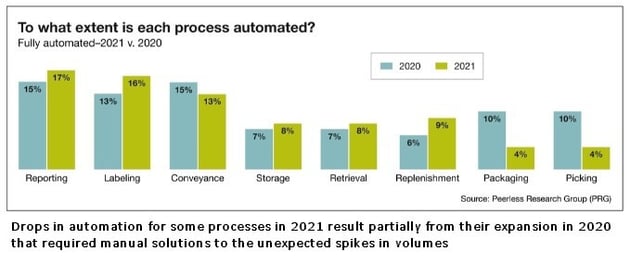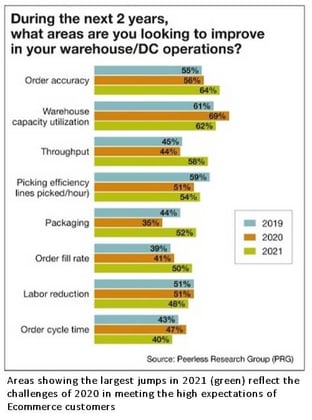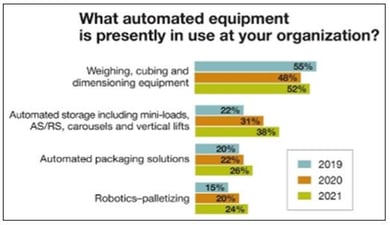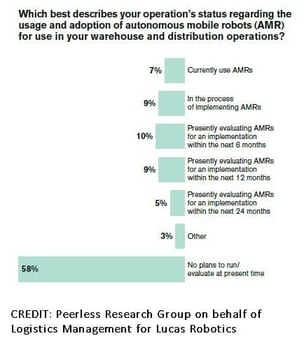
One of the most common questions we hear in our industry - and discuss among our own teams – is “how far will automation go and WHEN?” As a manufacturer working to improve productivity for our customers, it is a question that has implications for every part of our business – not just in planning the products we want to develop and market, but those we will need to use in our production process.
And while more and more of the “automation” discussion has become about robotics, there is still a LOT of room in the average warehouse to increase automation long before deploying any actual robots into the mix. In other words, the solutions will vary by not only your industry, but the maturity of your processes and the specific roles they play for your business.
Modern Material Handling just published a survey of readers regarding their plans and expectations for automation, which have evolved rapidly as a result of the pandemic. We’ll share some of the important highlights from that survey and look a little beyond as well into some aspects of how robotics will grow its role in warehouse automation too.
Like in almost every other aspect of the business in 2020, the movement towards automation accelerated, leading to many questions and challenges for facility managers who may have been thinking that their plans to automate were still a bit further in the future.
How Much Automation is Really Going On?
If there is one thing that is common in both robotics and the larger automation industry (and honestly, in ALL technology industries), it is the effectiveness of their communications that gives the impression that “Everyone is doing it!” and you will be the last holdout. There is a constant tension for decision-makers that pulls between wanting to modernize and have the best toys around, and not wanting to get ahead of your investment plan to endanger your success as a productive arm of your business.

Looking at the recent MMH survey, two things tend to stick out:
- “Fully automated” is just not a thing yet for a very large majority of facilities in ANY process area. And this illustrates that there will still be a yawning gap between the mega-facilities of Amazon and other Fortune 100 businesses and the more typical facility operated by 95% of all the other businesses out there. For now, it’s not necessary to meet their standard, but to beat the standard of your own industry.
- “Fully Automated” also DECLINED in some processes on a year-to-year basis, but there is a logical reason why this apparent anomaly may not be so surprising: Given how many facilities had to react quickly to the pandemic and the spikes in so many types of activities, it is not illogical to think that a lot of the additional volumes processed were done with manual solutions for lack of time to implement or expand existing automation. For example, a facility that had some degree of automation in getting pallets delivered to retail locations may have responded to the sudden spike in direct-to-consumer Ecommerce by setting up a room full of old-school packing stations with no conveyance, etc. This scenario would impact all of the processes showing a decline in then above chart.
Where Should You Start Looking to Automate?
 For surveys like this, the place to look for trends that may affect your business is in the year-to-year changes rather than the stack-rank of the various choices. One of the telling things about the avalanche that hit many DCs in 2020 is what is going to be the most sought-after areas of improvement in 2021.
For surveys like this, the place to look for trends that may affect your business is in the year-to-year changes rather than the stack-rank of the various choices. One of the telling things about the avalanche that hit many DCs in 2020 is what is going to be the most sought-after areas of improvement in 2021.
The most significant changes in the MMH survey for “where to improve in 2021?” are in “throughput”, “packaging” and “order fill rate”. These three areas of emphasis are a direct result of the fast-paced, hang-on-for-life, nature of the Ecommerce boom that forced everyone to pretend they had deployed their 2025 technology plan already – and get those results without having actually done it! Going into an Ecommerce-focused process environment literally overnight would exacerbate these specific processes, with “Order Fill Rate” reflecting both the bottlenecks in restocking and the customer dissatisfaction that would have stemmed from lost orders and inadequate WMS systems that could not monitor inventory status correctly.
The other telling factor – though not statistically relevant – is the slightly lower response to “Labor Reduction”, which probably does not come from a resistance to automation as much as the reality that there was more work than the existing labor could handle and you needed every available hour!
Finally, if we pull just the potential “movers” for 2021 for “What automated equipment do you presently use?” you can see the growth areas follow a similar pattern – a bigger investment in responding to what created the most pain in 2020.
 Automating storage addresses issues across multiple processes – Receiving, Putaway, Replenishment, and Inventory. It also provides the foundation for improving accuracy across all of these processes and speeding the movement of product between them. Many DCs found themselves cancelling customer orders for product they knew was in the facility but could not be found due to poor location management from poor labeling or Receiving/Putaway practices.
Automating storage addresses issues across multiple processes – Receiving, Putaway, Replenishment, and Inventory. It also provides the foundation for improving accuracy across all of these processes and speeding the movement of product between them. Many DCs found themselves cancelling customer orders for product they knew was in the facility but could not be found due to poor location management from poor labeling or Receiving/Putaway practices.
Automating packaging could include things as simple as tape machines, carton selection modules in your WMS (linked to the “weighing, cubing and dimensioning” response) or more automated machines like automatic boxing lines.
And lastly, robotics makes a small appearance here – for palletizing. But what about the bigger picture for Robotics?
Robotics is Apparently Not For Everyone – Yet
 It’s important to remember there is a very large industry dedicated to “automation” that does not involve leaping into the Robot age next week. The biggest players in the industry will lead the public perception of automation with their evening news segments showing robots busily running across dark warehouse spaces to get all the work done, but the reality for most DCs is that the robot age is still far off in the future. It doesn’t mean that there won’t soon be a robot that will get mass-adopted for a very specific purpose or process (i.e. a robot that receives a pallet and labels everything on it before putting it away? Possible!), but your warehouse has a lot of other lower-cost investments in standard automation that will take your productivity up in leaps and bounds before the right robot comes your way. This chart on the right from another recent survey by Peerless Research Group for Locus Robotics shows that only 7% of your peers are currently using AMRs (Autonomous Mobile Robots) versus 61% who currently have no known plans to use or even evaluate the use of them at this time. While being in the Luddite camp will probably not be a career-limiting move at this time, it does seem from the middle 32% that a larger swell of adoption is no more than 2-3 years out from our current place in time.
It’s important to remember there is a very large industry dedicated to “automation” that does not involve leaping into the Robot age next week. The biggest players in the industry will lead the public perception of automation with their evening news segments showing robots busily running across dark warehouse spaces to get all the work done, but the reality for most DCs is that the robot age is still far off in the future. It doesn’t mean that there won’t soon be a robot that will get mass-adopted for a very specific purpose or process (i.e. a robot that receives a pallet and labels everything on it before putting it away? Possible!), but your warehouse has a lot of other lower-cost investments in standard automation that will take your productivity up in leaps and bounds before the right robot comes your way. This chart on the right from another recent survey by Peerless Research Group for Locus Robotics shows that only 7% of your peers are currently using AMRs (Autonomous Mobile Robots) versus 61% who currently have no known plans to use or even evaluate the use of them at this time. While being in the Luddite camp will probably not be a career-limiting move at this time, it does seem from the middle 32% that a larger swell of adoption is no more than 2-3 years out from our current place in time.
When In Doubt, Go Back To Process
Whether or not you have your finger on the pulse of automation trends in your own industry, this is a reminder that the most important piece of work you can do on a daily basis to prepare for any kind of future automation is to continuously measure, tweak and improve each and every one of your core processes. We’ve seen in our own surveys how this is not yet a standard that everyone keeps, yet by neglecting it, you lose your best indicator of what type of automation you will need, when you will need it, and how much you need to plan to invest to get the ROI it would require to make it work.
What are you not getting done in the process space that you can identify today and give you the next piece of the puzzle you need to adapt your facility to the future?
Cover Photo Credit: Photo by Alex Knight on Unsplash